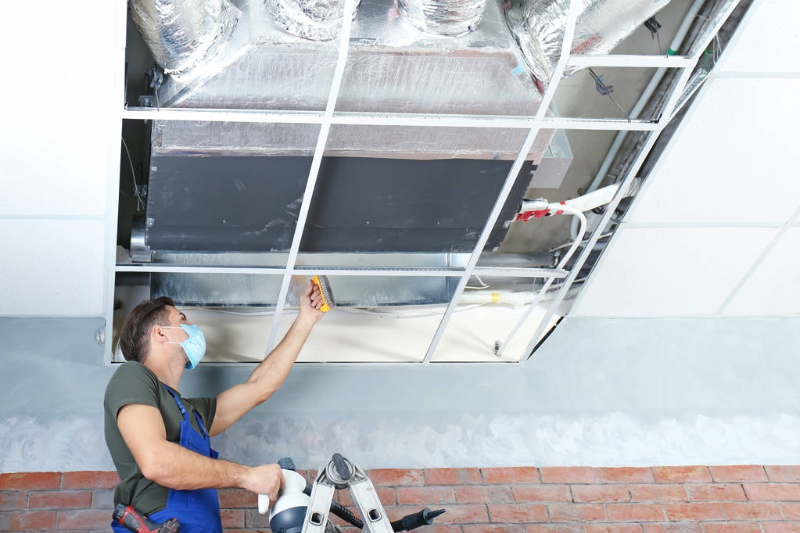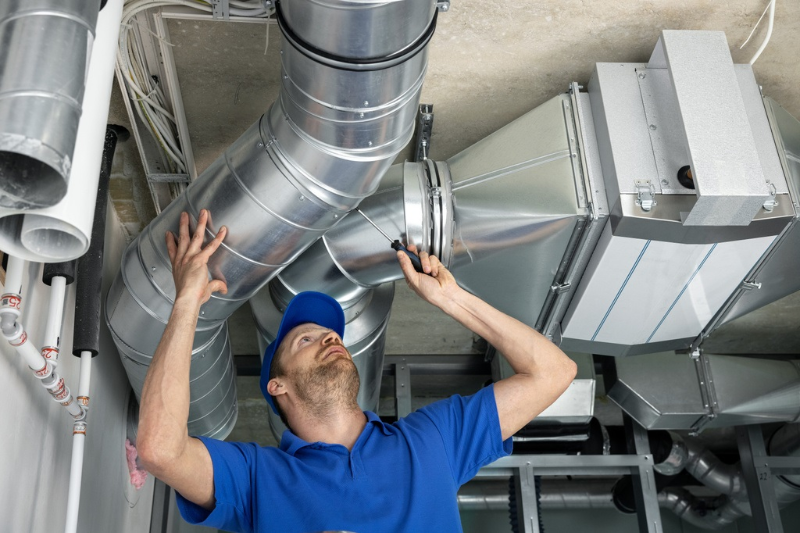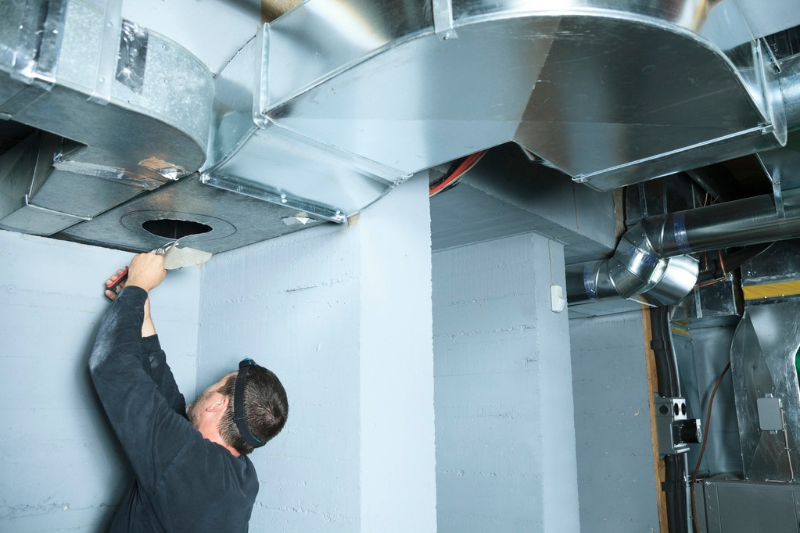Table Of Contents
Ducted air conditioning is a popular way to maintain a comfortable indoor environment, especially in larger spaces. Unlike split systems in each room, ducted systems operate through a centralised unit connected to a network of ducts. Ducted systems can be centralised, with a single central unit serving the entire house, or decentralised, with multiple smaller units catering to specific zones.
Centralised air conditioning systems provide uniform temperature control throughout the home, while decentralised systems offer flexibility by allowing different temperature settings in various areas. So, how does ducted air conditioning work? Read on to find out the answer to this question and more.
The Function of Ducted Air Conditioning Systems

Air intake and filtration process
Ducted air conditioning systems start by drawing air from your home through return ducts. This air passes through filters, removing dust, allergens, and other impurities. Filtration improves indoor air quality and protects the system’s components from debris.
Cooling process in the evaporator coil
The filtered air then moves to the evaporator coil, where the cooling magic happens. A refrigerant, often a particular type of gas, circulates through the coil, absorbing heat from the incoming air. As a result, the air is cooled, and the heat is transferred to the refrigerant.
Heat exchange in the condenser coil
The now-warmed refrigerant flows to the condenser coil, typically located in the outdoor unit. Here, the heat is expelled into the external environment, and the refrigerant is ready to start the cooling cycle anew. The condenser fan assists in dissipating the heat efficiently.
Refrigerant circulation and compression
The refrigerant undergoes compression and expansion facilitated by the compressor in the central unit. This cycle ensures a consistent and efficient heat transfer, allowing the system to maintain a desired temperature within your home.
Thermostat and temperature regulation
A thermostat controls temperature regulation in a ducted system, often placed in a central location for easy access. Modern air cons may feature smart thermostats that allow remote control through mobile devices, enabling you to adjust settings even when you’re away from home.
Ductwork Design and Layout

Importance of proper duct design
Proper ductwork design is crucial for the optimal functioning of a ducted air conditioner. An efficient design considers factors such as the size of the residential or commercial space, the number of rooms, and the layout. Well-designed ducts ensure even airflow, preventing hot or cold spots in different areas.
Duct sizing and airflow dynamics
Correct duct sizing is essential to maintain a balanced airflow. Undersized or oversized ducts can lead to reduced efficiency and increased energy consumption. Airflow dynamics play a role in distributing air evenly, and a well-designed system will account for these factors to provide consistent comfort.
Zoning systems for temperature control
One of the advantages of ducted systems is the ability to create zones within your home. Zoning allows you to customise the temperature, optimising energy use and enhancing comfort. This is particularly beneficial in larger homes where certain rooms may be used less frequently.
Placement of supply and return ducts
The strategic placement of supply and return ducts is essential for efficient air distribution. Supply ducts deliver conditioned air to rooms, while return ducts bring air back to the central unit. Proper positioning ensures the system operates smoothly and maintains a consistent temperature throughout your home.
Insulation and air leakage prevention
Duct insulation is crucial for energy efficiency. Insulated ducts help prevent heat gain or loss as air travels through the system. Additionally, sealing gaps or leaks in the ductwork is essential to avoid energy wastage and maintain the system’s overall efficiency.
Installation and Maintenance Considerations

Professional installation procedures
Installing a ducted air conditioning system is a task best left to professionals. A qualified HVAC technician will assess your home’s specific requirements, design an efficient system, and ensure the installation is done correctly. Professional installation not only guarantees optimal performance but also extends the lifespan of the equipment.
Regular maintenance for optimal performance
Routine maintenance is essential to keep your ducted system running smoothly. Regular tasks include cleaning or replacing filters, inspecting ducts for gas leaks, and checking refrigerant levels. Professional maintenance should be done at least once a year to address any potential problems and ensure peak efficiency.
Common issues and troubleshooting
Despite their reliability, ducted systems can encounter issues over time. Common problems include duct leaks, thermostat malfunctions, and refrigerant issues. Understanding these potential issues and addressing them promptly can prevent more significant problems and ensure uninterrupted comfort.
Upgrading and retrofitting ducted systems
As technology evolves, upgrading or retrofitting your ducted air conditioning system may be considered. Upgrades can include:
- Installing a more energy-efficient central unit.
- Incorporating smart thermostats.
- Even expanding the system to accommodate changes in your home.
Cost-effective maintenance tips
Maintaining a ducted system doesn’t have to break the bank. Simple tasks like regularly cleaning or replacing filters, keeping vents unobstructed, and ensuring proper insulation can go a long way in preserving the efficiency of your system. These cost-effective measures contribute to both short-term and long-term savings.
Advantages & Limitations of Ducted Air Conditioning

Enhanced comfort and air quality
One of the advantages of ducted air conditioning is the ability to provide consistent comfort throughout your home. The even distribution of conditioned air eliminates temperature variations, creating a comfortable living environment. Additionally, the filtration process improves indoor air quality by removing particles and allergens.
Aesthetic and space considerations
Ducted systems offer a sleek and discreet solution to temperature control. Unlike individual units that may occupy valuable wall or floor space, ducted systems are hidden from view. This not only enhances the aesthetics of your living space but also allows for greater flexibility in interior design.
Energy efficiency and cost savings
Efficiency is a hallmark of well-designed ducted air conditioning systems. The ability to create zones and regulate temperature in specific areas contributes to energy savings. While the initial installation cost may be higher than that of individual units, the long-term energy efficiency and reduced utility bills can lead to significant cost savings.
Noise levels and acoustic considerations
Ducted systems are known for their quiet operation. The noisy components, such as compressors and fans, are located outside the living spaces, minimising indoor noise levels. This is particularly advantageous in homes where a peaceful and quiet atmosphere is desired.
Environmental impact and sustainability
Ducted systems can be environmentally friendly when designed with energy-efficient components. Additionally, proper maintenance and upgrades to more eco-friendly units contribute to reducing the overall environmental impact of your cooling system.
Choosing the Right Ducted Air Con System for You

Assessing home size and layout
The size and layout of your house are vital in determining the appropriate size and capacity of the ducted system. A professional can perform a load calculation to ensure the system meets the requirements of your space.
Energy efficiency ratings and SEER values
When selecting a ducted air conditioner, pay attention to energy efficiency ratings. The Seasonal Energy Efficiency Ratio (SEER) standards indicate how efficiently the system uses electricity. Higher SEER values correspond to greater energy efficiency.
Integration with smart home technology
Modern ducted systems often have smart features, allowing you to control your system remotely. Smart thermostats, scheduling options, and compatibility with home automation systems enhance convenience and energy management.
Budget considerations and cost analysis
While ducted systems offer long-term cost savings, it’s essential to consider the initial installation cost. Work within your budget and weigh the upfront expenses against the expected energy savings and comfort benefits over the system’s lifespan.
Consulting with HVAC professionals
Choosing the right ducted system involves comprehensively understanding your home’s requirements. Consult with HVAC technicians who can assess your needs, recommend suitable brands, and ensure proper installation.
Empower Your Home’s Comfort with Ducted AC
Ready to elevate your home’s comfort and efficiency? Consider the seamless and versatile solution of ducted air con. From even temperature distribution to energy savings, these systems offer many benefits.
Take the next step towards a more comfortable living space – consult with HVAC professionals, explore energy-efficient options, and make the right decision tailored to your needs. Embrace the future of home cooling and experience the difference that a well-designed ducted system can make. Your ideal indoor climate is just a step away.



